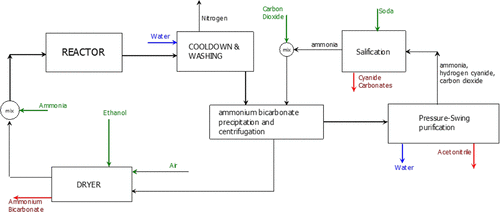当前位置:
X-MOL 学术
›
ACS Sustain. Chem. Eng.
›
论文详情
Our official English website, www.x-mol.net, welcomes your feedback! (Note: you will need to create a separate account there.)
Acetonitrile from Bioethanol Ammoxidation: Process Design from the Grass-Roots and Life Cycle Analysis
ACS Sustainable Chemistry & Engineering ( IF 8.4 ) Pub Date : 2018-03-12 00:00:00 , DOI: 10.1021/acssuschemeng.8b00215 Antonio Tripodi 1 , Elnaz Bahadori 1 , Daniele Cespi 2, 3 , Fabrizio Passarini 3, 4 , Fabrizio Cavani 3, 4 , Tommaso Tabanelli 3 , Ilenia Rossetti 1
ACS Sustainable Chemistry & Engineering ( IF 8.4 ) Pub Date : 2018-03-12 00:00:00 , DOI: 10.1021/acssuschemeng.8b00215 Antonio Tripodi 1 , Elnaz Bahadori 1 , Daniele Cespi 2, 3 , Fabrizio Passarini 3, 4 , Fabrizio Cavani 3, 4 , Tommaso Tabanelli 3 , Ilenia Rossetti 1
Affiliation

|
The growing interest for new routes to obtain acetonitrile led to the development of catalysts active toward the ammoxidation of various substrates. Among these, a C2 molecule such as ethanol represents a good choice in terms of atom economy and, being renewable, sets the basis for a long-term sustainable process. This paper describes a fully integrated, newly designed process for the production of acetonitrile from bioethanol, currently not present in the literature. The target is the production and purification of 10 kg/h of acetonitrile, unit of production used for calculations, obtained from ethanol, ammonia, and air as raw materials. All the byproducts, mainly ammonium bicarbonate and sodium cyanide, are considered marketable chemicals and represent an added value, instead of a disposal issue. Their optimized recovery is included in this flowsheet as a basis for the future economic assessment of the system. The process consumes CO2 without its direct emission. In principle, all the carbon atoms and 90% of the nitrogen atoms are turned into reaction products, and the main loss is gaseous N2. The process design has been performed by means of the Aspen PLUS process simulator, on the basis of literature data and other experimental results. In addition, for an evaluation of the potential benefits of the innovative biobased route, a life cycle analysis was carried out including all the stages involved in the bioacetonitrile production (from raw materials extraction up to the gate plant). The results were then compared with those achieved for the traditional fossil route (SOHIO process), showing a sensible decrease of the environmental burdens in terms of nonrenewable resources and damage to ecosystems (e.g., toxicity, climate change, etc.). Finally, a simplified sensitivity analysis was carried out by substituting the starting raw material for the production of bioethanol (corn) with other materials conventionally used worldwide, such as sugar cane and wood. The latter option seems to make the system more competitive in terms of carbon neutrality, thanks to the usage of the residual lignocellulosic fraction available on the market.
中文翻译:

生物乙醇氨氧化产生的乙腈:基层的工艺设计和生命周期分析
对获得乙腈的新途径的兴趣日益浓厚,导致了对各种底物的氨氧化具有活性的催化剂的开发。其中,就原子经济而言,诸如乙醇之类的C2分子是一个不错的选择,并且可再生,为长期可持续过程奠定了基础。本文介绍了从生物乙醇生产乙腈的完全集成的,新设计的工艺,目前尚无文献报道。目标是以乙醇,氨和空气为原料,以10 kg / h的乙腈的生产和提纯速度作为计算单位。所有副产物,主要是碳酸氢铵和氰化钠,被认为是可销售的化学品,代表着附加值,而不是处置问题。他们的优化回收率包含在此流程图中,作为将来对该系统进行经济评估的基础。该过程消耗一氧化碳2无其直接发射。原则上,所有碳原子和90%的氮原子都变成反应产物,主要损失是气态N 2。已根据文献数据和其他实验结果,借助Aspen PLUS工艺模拟器进行了工艺设计。另外,为了评估创新型生物基路线的潜在利益,进行了生命周期分析,包括生物乙腈生产中涉及的所有阶段(从原料提取到浇口装置)。然后将结果与传统化石路线(SOHIO过程)获得的结果进行比较,显示出在不可再生资源和对生态系统的损害(例如毒性,气候变化等)方面,环境负担显着减少。最后,通过将用于生产生物乙醇(玉米)的原料替换为世界范围内常规使用的其他原料,进行了简化的灵敏度分析。如甘蔗和木材。后一种选择似乎使该系统在碳中和方面更具竞争力,这要归功于市场上剩余的木质纤维素残留物的使用。
更新日期:2018-03-12
中文翻译:

生物乙醇氨氧化产生的乙腈:基层的工艺设计和生命周期分析
对获得乙腈的新途径的兴趣日益浓厚,导致了对各种底物的氨氧化具有活性的催化剂的开发。其中,就原子经济而言,诸如乙醇之类的C2分子是一个不错的选择,并且可再生,为长期可持续过程奠定了基础。本文介绍了从生物乙醇生产乙腈的完全集成的,新设计的工艺,目前尚无文献报道。目标是以乙醇,氨和空气为原料,以10 kg / h的乙腈的生产和提纯速度作为计算单位。所有副产物,主要是碳酸氢铵和氰化钠,被认为是可销售的化学品,代表着附加值,而不是处置问题。他们的优化回收率包含在此流程图中,作为将来对该系统进行经济评估的基础。该过程消耗一氧化碳2无其直接发射。原则上,所有碳原子和90%的氮原子都变成反应产物,主要损失是气态N 2。已根据文献数据和其他实验结果,借助Aspen PLUS工艺模拟器进行了工艺设计。另外,为了评估创新型生物基路线的潜在利益,进行了生命周期分析,包括生物乙腈生产中涉及的所有阶段(从原料提取到浇口装置)。然后将结果与传统化石路线(SOHIO过程)获得的结果进行比较,显示出在不可再生资源和对生态系统的损害(例如毒性,气候变化等)方面,环境负担显着减少。最后,通过将用于生产生物乙醇(玉米)的原料替换为世界范围内常规使用的其他原料,进行了简化的灵敏度分析。如甘蔗和木材。后一种选择似乎使该系统在碳中和方面更具竞争力,这要归功于市场上剩余的木质纤维素残留物的使用。



























 京公网安备 11010802027423号
京公网安备 11010802027423号